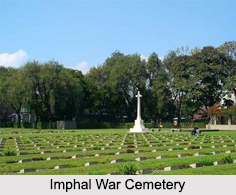 Located in the north eastern city of Imphal in the state of Manipur, the Imphal War Cemetery was built to commemorate the memories of the British and Indian soldiers who died during the World War II. The cemetery is maintained by the Commonwealth War Graves Commission and has 1600 Commonwealth burials from the period of the Second World War.
Located in the north eastern city of Imphal in the state of Manipur, the Imphal War Cemetery was built to commemorate the memories of the British and Indian soldiers who died during the World War II. The cemetery is maintained by the Commonwealth War Graves Commission and has 1600 Commonwealth burials from the period of the Second World War.
Overview of Imphal War Cemetery
In 1944, the Japanese army fought their way from Rangoon all the way to Imphal and invaded India through the border state of Manipur. Originally, the Imphal War Cemetery was a burial site for some 950 soldiers who died in the battle. Later, the Army Graves Service brought in graves from two other burial sites, thereby increasing the numbers to around 1,600 graves. The cemetery is serene and well maintained and carries little stone markers with bronze plaques recording the sacrifices of those gallant soldiers. On the 70th anniversary of the Battle of Imphal, which was on 27th June, 2014, a memorial service was organised at the cemetery.
Visiting Information on Imphal War Cemetery
The Imphal War Cemetery is located in a small locality of Dewlahland about 10 km away from the Imphal International Airport. By roadways, the cemetery can be accessed from the Imphal- Dimapur Highway 39.
This article is a stub. You can enrich by adding more information to it. Send your Write Up to content@indianetzone.com.



















